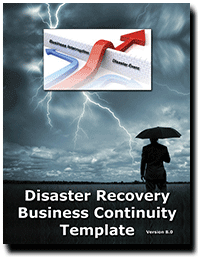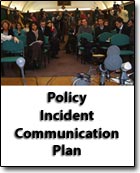Policy for Communication with the Media Part of DR/BC Plan
Communication with the Media - How information is disseminated can make or break an enterprise after an event has occurred. It is difficult if not impossible to undo inaccuracte or "bad" information once it is out there in the age of 7 x 24 news coverage and the Internet.
Order Disaster Plan Template Download DRP Customer Base
 A crisis event is any situation that threatens the integrity or reputation of your company. These situations can be any kind of accident, fire, flood or manmade disaster that could be attributed to your company. It can also be a situation where in the eyes of the media or general public your company did not react to one of the above situations in the appropriate manner.
A crisis event is any situation that threatens the integrity or reputation of your company. These situations can be any kind of accident, fire, flood or manmade disaster that could be attributed to your company. It can also be a situation where in the eyes of the media or general public your company did not react to one of the above situations in the appropriate manner.
If handled correctly the damage can be minimized. One thing to remember that is crucial in an event is tell it all, tell it fast and tell the truth. If you do this you have done all you can to minimize the situation. When a situation arises the first thing you should do is contact your CEO and the chief of your public relations department. The sooner you get those two organizations involved the sooner you can implement this plan.
Once a disaster has occurred, your company needs to communicate with its employees, associates, suppliers, customers, shareholders, investors, and other stakeholders. Here are factors that need to be considered:
- Is your CEO an effective media spokesperson?
Just because someone is a CEO does not mean that they will be an effective media spokesperson. It might be the way they look on camera or some physical issue that would not present the enterprise in the best light.
- Is your CEO the right spokesperson?
The number one priority for a spokesperson in a crisis is to communicate information clearly and effectively to those affected by it. If the event is an Information Technology failure, like a security breach, the CIO might be better suited to communicate the problem. Put forward the one most relevant and most able to communicate with clarity.
- Does the event involve loss of life?
If your organization is at the heart of a crisis where people have been killed, it is almost certain that your top executives will face the media. In these circumstances a message from the very top is essential - not to do this will be seen as cold and uncaring.
- Will the event cause any permanent damage to the enterprise's on-going operations?
At the start of the event, before all the facts are know, it is easy to over-estimate the scale of a crisis. You need to make a cold, hard assessment of the gravity of situation - from an external perspective, in order to properly assess its seriousness. Be very wary of putting your CEO forward in all but the most serious of crises. Once you set the benchmark for CEO visibility, he/she will be expected to appear for all future crises of a similar magnitude. Pitch the benchmark too low and he/she could be doing nothing but media interviews for the next three years.
Order DRP BCP Template Sample DRP BCP Template

